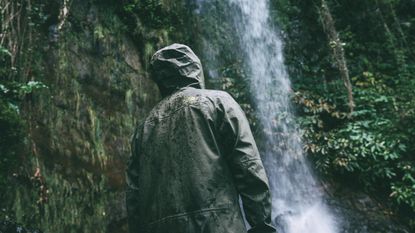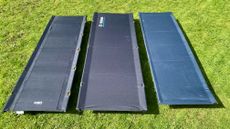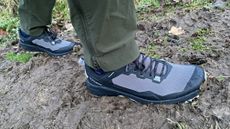Is your old favourite jacket getting a bit soggy in the rain? Former trusty Gore-Tex armour running gradually colder, with lots of condensation inside? You need a ‘reproof’ - or in other words, re-energise your jacket’s waterproofing.
Today's best waterproof jackets are awesome in many ways: light, durable, windproof and waterproof in the worst weather you care to find. Most modern outdoor jackets rely on one of two technologies to keep the damp out - either a surface treatment of DWR or a simple wax, and an internal membrane such as GoreTex/eVent or equivalent. There is a downside to this initially potent tech combo – after a few months of regular wear, you’ll notice something amiss – the warning signs of ‘wetting out’, sogginess inside, or both.
- You'll find more advice in our waterproof jacket care guide
- Don't need something waterproof? These are the best winter coats
‘Wetting out’ is mostly down to wear and tear on the face fabric of your jacket, allowing water to soak in rather than bead up and run off like it did when new, while damp sensations inside means your formerly high-tech membrane is now clogged with unsavoury substances.
Of course, these signs might convince you that it’s time for a new jacket, and if they’re caused by damage to the membrane itself then that is really the only sensible tactic. But usually, the solution is much easier and cheaper - here’s how to waterproof a jacket.
Products needed to waterproof a jacket
There are a host of products on the market that will replace the factory DWR coating on your jacket and get it waterproof again, but choose wisely. Spray or wash-in are your main choices here, from brands such as Nikwax, Graingers and MountVal.
The major choices though, are brand-agnostic - make absolutely certain that the product you buy is suitable for the jacket you’re planning to reproof, as some sprays are intended for non-membrane jackets like motorbike leathers, and mixing them up is not a good idea.
Also make sure that you choose a reputable firm that has a fluorocarbon-free guarantee, as these are pretty toxic and unnecessary. Most UK brands now rely on water-based treatments, which is good news for you, the wider environment, and your washing machine too.
Grangers have recently begun offering all-in-one packs, which remove any confusion or multiple-ordering from the equation, while Nikwax offers combo wash and proof kits, which are also easy-all-in-one options.
Benefits to waterproofing a jacket
The big benefit to reproofing a jacket is the most obvious - it’ll shed rain again and keep you dry in the winter downpours. However, there are a bunch of side benefits which are almost more important. You save a fortune compared to buying a new jacket, and most vitally you don’t need to throw away your old one, saving the planet considerable angst.
As we’ll detail below, the first step in waterproofing a jacket is to clean it well, which has a critical set of benefits too. Not only will it smell and look factory-fresh again, but the membrane will be able to work properly once more, freed from clogging mud and gunk. This will rocket the breathability back to almost-new levels, making for a much more pleasant internal environment and battling that feeling of damp.
How to waterproof a jacket
There are three main steps to waterproofing a jacket:
Repair
It’s worth making any small repairs before reproofing. Small holes can be closed with SeamGrip, larger rips might need patching or sewing up. If this is beyond your abilities panic not, most outdoor brands will be able to either repair or patch in-house themselves or recommend a local expert, so that broken zip doesn’t mean the end for your favourite waterproof.
Wash
Cleaning the grit and grime off your jacket to give a nice clean surface is essential, giving the reproofing mix the best chance of sticking, as well as de-gunking the membrane. There are plenty of specialist cleaners on the market, such as Nikwax Tech Wash and Grangers Performance Wash, which both do an excellent job, while pure soap flakes are a cheaper (albeit harder to source) alternative.
Assuming you’re using a home washing machine (on a cool setting of course) the two ‘tricks’ here are not overloading it (two jackets max) and most importantly rinsing out any residue of normal detergent and softener before you begin, as your technical gear won’t like them.
Many water-based reproofing mixtures will need to be applied to a wet jacket, so check first before carefully drying it!

Reproof
Finally, apply your chosen reproofing substance, available in a vast array of flavours for pretty much every possible outdoor item, from tents to shoes, boots to base layers. Needless to say, do pick the correct flavour for your jacket, and apply according to the instructions.
If you’re still near that washing machine then the ‘wash-in’ versions are usually best on jackets, but if you’re not then there are numerous spray options available. The spray options tend to be more popular for reproofing things like rucksacks and tents, but all the major brands offer Gore-Tex reproofing in spray bottles. Hanging the jacket on an outdoor washing line is an ideal tactic, as it can then be left to dry naturally (in theory).
Enjoy!
The order of these steps might vary according to your jacket and which product you’ve chosen, but overall the result should be pretty similar - a clean, repaired and factory-fresh waterproof jacket ready for adventure. The only question now is where to go and test it first…?
Liked this?











